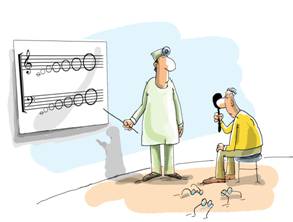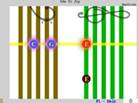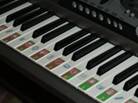 |
|
by Hellene Hiner
Because you go to a gym and use a stationary bicycle for cardiac exercise, does it mean that you can ride a real bike? Of course not! Because riding a bicycle involves a complex set of skills. You do not learn how to balance on a stationary bicycle, yet this is a missing but necessary link in training to ride a real one.
What would happen if you try to ride a real bike after training on a stationary bike? If you are an athletic type with a good sense of balance and coordination, it is less likely that you would be afraid of getting hurt if you fall off. Someone less skilled, however, could be afraid of falling, or fearful of even trying.
This is exactly what has happened for many centuries with piano learning, because there is a missing but necessary link in music education, just as there is in the example of training for a race on a stationary bike. This link is the visual perception of score and keys.
Learning a complex set of skills requires that all the components be developed together from the very start to build a strong, unified network. Losing any of the separate parts of the network, even for a short time, complicates the learning process for many students, except perhaps the most structured players.
Piano playing is about the relationship between the piano keys and musical notes – with plenty of looking and little actual seeing.
What is the difference between looking and seeing? For a moment, imagine yourself for the first time looking at a sheet of piano music and knowing that it is in a language that you do not know. Or imagine yourself standing in someone else’s kitchen looking for the saltshaker among all the spices on the shelf, but you are unable to see what the hostess could find with closed eyes. When a student of any age first stares at the piano keys and a music score, he/she is blind in the same way you would be looking for the salt among all the spices on the shelf. When a person cannot see, he/she needs to develop the skill to see, not the textbook knowledge about how to see things. Most piano students are constrained by music education that keeps them blind. Many well-known schools try to deal with problem of music blindness differently, but all the approaches have the same foundation – bondage on muscle memory. This is exactly how we teach blind people. How do the blind learn? They learn by touch. They also need assistance.
Russian music educators deal with blindness by endlessly playing scales and finger exercises and studies. Method books creators all over the world deal with blindness by offering 'hand position' curriculum, when hands and fingers are fastened to certain keys. Some schools have declared that reading music is not necessary at the beginning, and that playing “by ear” is a more fruitful approach. Some schools present beginners' sheets with finger numbers. Some inventors create systems of training muscles by blindly chasing lit keys or moving colorful objects on a monitor screen.
Some inventors use interactive computer programs to try to teach the eyes the knowledge of what they need to see.
These methods are like the stationary bicycle! They all overlook one important component of the complex skill to play piano: visual/spatial integration. Therefore, if we want to make piano lessons more effective, our duty is to let people SEE the music notes and their relationship to the piano keys from the very first steps.
How to do it? It is not as hard as one might think! I can be accomplished in the same way that we do it in day-to-day life. When we deal with something that we have trouble seeing, we MARK it, underline it, or we add highlights and labels! This helps our eyes to see. But it is not enough to use colorful markers and color music notes. We have to do it in a logical and organized way, in a way that makes sense for our students! When we classify similar looking things, we have to consider their outstanding features in order to add visual support for eyesight. Look at shelves of spices in grocery stores! There are hundreds of the same looking jars, but they are organized in a way to help our eyes to get what we want: each jar has a name on it, a picture of the spice and they are placed in alphabetical order.
Many kids are capable of learning letters before they even go to school, because people created brightly marked alphabet letters for them. Remember, how we teach children with cards or blocks? Each letter is presented in large print with pictures and colors that help children to see the connection between the abstract letter, picture and phonetic pronunciation. For example, kids see a picture of an apple, say 'apple' and figure out the letter A!
The same strategy could be used with music notes! But when we chose, for example, 12 different colors for 12 different piano keys we miss the whole point of visual support in learning. Can these 12 colors add to the fact that 12 different keys have 12 different sounds? Not really. They simply add confusion.
Each music note has outstanding features. We have to determine all of them and make them obvious for the beginner's eyesight.
Each music note has outstanding features.
- If spaces and lines are the same tracks, why don't we present them with the same width on elementary level? Kids won't think, that white track is a 'break between lines' any more!
- If music notes are all either on spaces or on lines, why don't we color them in two contrast colors for beginners eyes to instantly catch the difference?
- If Treble and Base Clefs are mostly for different hands, the best way to present them –is to give them different colors, too, but colors of let's say, a tree. It would help to explain gradual changes in pitch – from dark to light, from trunk to crown.
 If music notes go up and down and corresponding keys – right and left, why don't we turn the Grand Staff sideways in elementary presentation to line notes with keys and to help beginners to SEE a straight link between them right away?
If music notes go up and down and corresponding keys – right and left, why don't we turn the Grand Staff sideways in elementary presentation to line notes with keys and to help beginners to SEE a straight link between them right away?
 If music notes have only seven names for all the keys and sounds, why don't we place a label of these names on each note and a key? This way a beginner will SEE the relationship easily, not struggle looking for information.
If music notes have only seven names for all the keys and sounds, why don't we place a label of these names on each note and a key? This way a beginner will SEE the relationship easily, not struggle looking for information.
- If it is so hard to shift eyesight along all lines and spaces, why don't we use computer interactivity to support focus at the elementary stage and then moderately develop its ability to shift?
Many teachers and many parents are afraid to give beginners too much support, because they think that they'll become dependant upon them. But street signs didn't ever spoil any driver, especially when an area is unfamiliar and the road is shrouded by fog. Don't you remember your own frustration that the signs were too small and blurry, when you badly needed to see where to go? But we never even look at the signs, once we know way.
Today is a time to decide whether we give our students a better tool to see music notes and piano keys and to learn effectively - or to keep them in darkness just because we learned by a different method. For many former piano students it is so obvious what should be done! But this a is very difficult decision to make for major music educational institutions, music publishers and music teachers. There is a lot of money already invested in method books and music sheets, all which attempt to explain to eyes what they ought to see and present the traditional Grand Staff from the very start. The major question here: in whose best interests do we have to decide – in the interest of people who have personal/financial reasons to maintain the status quo, or in the best interest of our kids?
By continuing music lessons in 'blind mode' millions of parents not only waste a lot of money in very slow and ineffective ways of teaching piano, they invest in ways of teaching music that could completely change their kids lives for the worse… by introducing frustration and failure at an early age.
